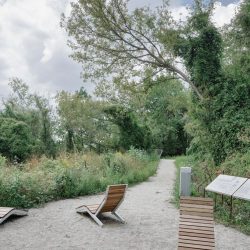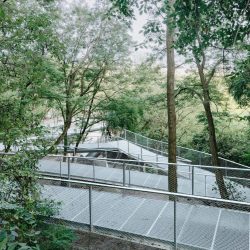
The Warsaw Uprising Mound Park is the Fourth Nature refuge created on an anthropogenic hill. For years, this site served as a repository for the debris from Warsaw after the city was destroyed in World War II, gradually giving rise to an artificial hill that now stands 35 metres above the surrounding flat and marshy landscape. After the landfill was closed in the mid-1960s, the hill became overgrown with vegetation that, over time, transformed into a ruderal “forest”.
In the 1990s, at the top of the mound, at the initiative of one of the participants of the Warsaw Uprising, Eugeniusz Ajewski “Kotwa,” a monument commemorating the symbols of the Polish resistance movement during World War II was erected. This modest initiative, preceding the official state narrative, turned this place into a venue for annual commemorations of the Warsaw Uprising.
However, this did not change the public perception of the mound, which was considered a place that was difficult to access and unsafe.
Its adaptation into a public park involved recognising its ecological and symbolic potential and making various uses of the rubble found on site. The Mound area was thus reclaimed in three different ways: symbolically, physically and by the Fourth Nature:
Reclaiming the meaning.
Project had to befit the site’s significance and provide a recreational space for the residents of the newly constructed housing estates in its vicinity. New spaces associated with the historical significance of this place were created and adapted. The interventions focused mainly on adjusting the area of the mound to the needs of all users, which, due to the complex terrain, required the introduction of footbridges and artificial ravines. Recreational functions were provided by creating numerous resting and walking areas, including a naturalistic playground. The creation of the park significantly improved the accessibility of green areas for the residents of the district and their sense of security.
Reclaiming by the Fourth Nature.
The Mound is a degraded area, a brownfield, a wasteland reclaimed by the Fourth Nature. It was a priority to preserve the existing invasive and ruderal vegetation, which served ecosystem services for the city, however bioblitz survey carried out with local community proved low biodiversity on the mound. It was necessary to enrich this habitat. The project’s starting point was observing natural processes initiated by pioneer and invasive species and further modelling them towards climax communities – novel ecosystems. This can lead to a change in the paradigm of aestheticising urban nature in favour of exposing its authenticity. The adopted environmental strategy include also supporting the soil-forming process by retaining organic matter and surface water runoff, introducing micro-retention (wooden gutters, fascine drains) and implementng bioreceptive rubble concrete.
A meadow that grew over the ruins of Warsaw in 1945 was sown again on the rubble fields, and its species composition is known thanks to the pioneering historical publications of Prof. Roman Kobendza. Finally the tiny forests was planted together with the local community using Professor Miyawaki’s method. Developed landscape management strategies contribute to reducing maintenance costs and increase resilience to climate change.
Reclaiming rubble.
The enormous amount of debris in post-war Warsaw was a problem but also a resource—the raw material for producing rubble concrete blocks from which numerous buildings have been built. Warsaw became a precursor of the circular economy; we wanted to refer to this heritage. Our project implemented several strategies for recycling rubble extracted during earthworks, all of which, following the conservator’s decision, remained on site:
– The most important was an innovative technology for producing modern rubble concrete, which forms the ravines’ retaining walls and the Mound’s base. Over time, this local anthropogenic rock, Warsaw urbanite, will be covered with moss and gradually assimilated by surrounding nature. Before that happens, we can see the remains of old Warsaw embedded in rubble concrete: bricks, stove tiles and balusters. The slopes of the ravines resemble the geological layers of an anthropogenic hill, and are in fact a record of the daily manual labour of the workers and their aesthetic decisions.
– Another strategy was to repurpose the rubble as filling material for the gabions in the Lapidary, designed as a labyrinth of “ruins”.
– The fair-sized remains of destroyed buildings were labelled and displayed within the park and along the grand avenue leading to the main monument on top of the hill.
Using rubble and natural materials in the context of a circular economy contributed to waste reduction and minimizing adverse environmental impact. Outdoor exhibitions and the highlighting of rubble as a valuable historical resource have built a sense of belonging to this place.
_
Landscape architecture: topoScape
Architecture offices involved in the design: Archigrest
Location: Bartycka Street, Warsaw, Poland
Design year: 2020-2021
Year Completed: 2023
Authors:
Archigrest: Maciej Kaufman, Marcin Maraszek
topoScape: Justyna Dziedziejko, Magdalena Wnęk
Cooperation: Karolina Potębska, Agata Holdenmajer, Natalia Janek, Jerzy Przychodni, Rafał Murawski, Joanna Chylak, Anna Sternytska, Agnieszka Tama
Structural design: Konbud Krzysztof Guraj, Paweł Komorek
Concrete technology: TBAiS Krzysztof Kuniczuk
Phytosociological consultation: Piotr Sikorski
Exhibition – heritage trail: Adam Przywara
Exhibition – nature trail: Kasper Jakubowski
Visual identity and the graphic design of exhibitions: Kaja Kusztra
General contractor: Sorted sp. z o.o.
Sponsored by: Capital City of Warsaw
Area: 82,919 m²
Investment cost: EUR 5,300,000



























